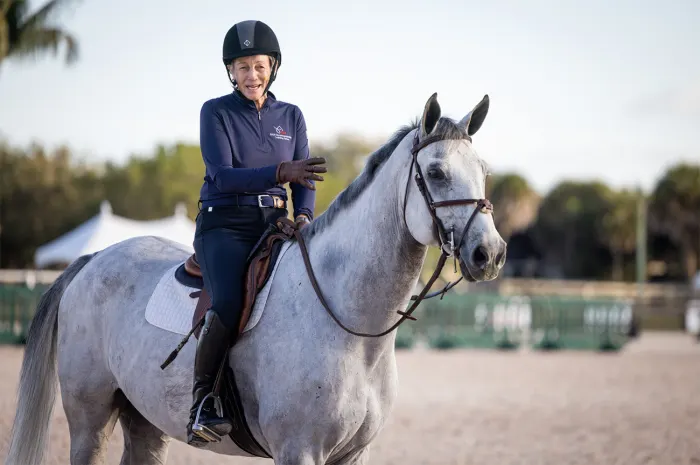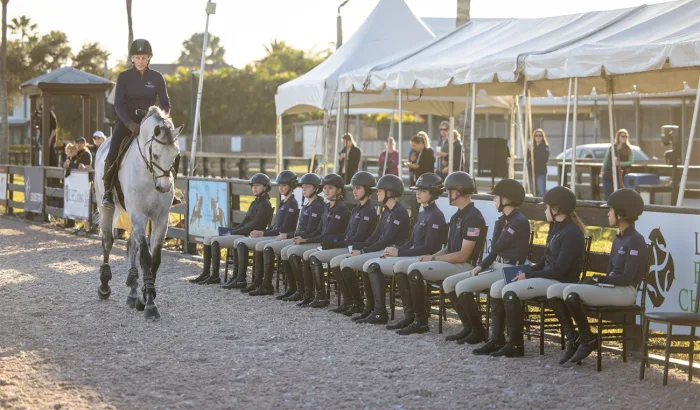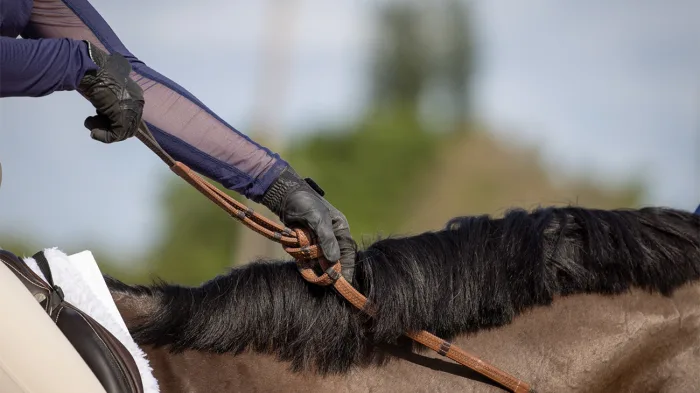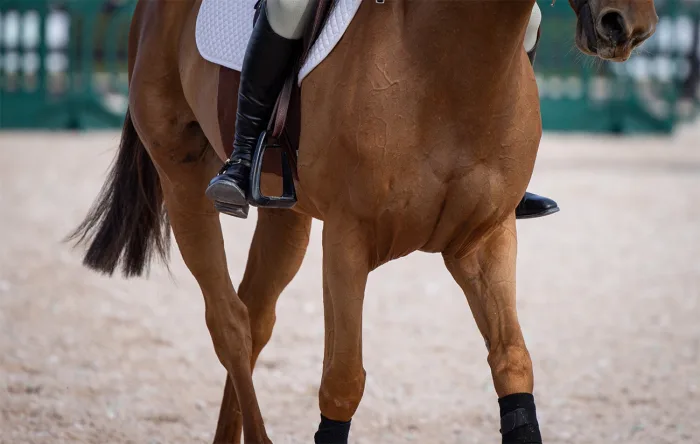Position is critical to good jumper riding, but a rider must not only look the part in the saddle, they must be effective and responsive to their horse. That was five-time Olympian Anne Kursinski’s message to 11 young riders during the first mounted session of the 2024 USEF Horsemastership Training Series, held Jan. 4-7 in Wellington, Florida.
Kursinski, who is well-known for her punctuality, was scheduled to begin the flatwork session with a demonstration ride at 8 a.m. Friday, and by 7:47 a.m., she was trotting around on Amaretto, an 8-year old Oldenburg (Armani Code—Stagranny) owned by trainer Missy Clark and North Run, greeting observers while she took the dapple gray through several soft walk-to-trot and trot-to-walk transitions to get his attention on her.
Once the clinic participants (with several changes to the original list: Mia Bagnato, Carlee McCutcheon and Nora Nauss took the places of Sofia Cady, Taylor Cawley, Caroline Signorino and Elise Stephens) took their seats in their chairs on the rail, Kursinski rode over to introduce herself and began to explain the importance of a rider’s body mechanics, a topic that mirrored lectures from several presenters the riders heard from during unmounted lectures the previous day.

“Preparing you and your horse to jump is all about awareness of your body and your horse’s body,” Kursinski said. “You should be centered in your body over the horse. Your heels should be down with your hands in front of you. You have to maintain your position. Watch McLain Ward ride: He could win the equitation finals right now in any of the jumper classes he competes in. If he can control himself, he can control his horse.”
Kursinski also spent time discussing how she uses her legs on the horse, specifically walking the young participants through how her leg functions in exercises such as the shoulder-in, haunches-in, circles, half-circles, and lengthening and shortening of stride. Her years of experience shine through in her riding; Kursinski can effortlessly go from one lateral exercise to the next with very little movement or change in her position. Every aid is smooth and invisible.
“There’s a rhythm to my leg—it’s like a heartbeat,” Kursinski said. “I touch the horse, I release. I hold him there with my seat; my legs are very light against his sides. The whole time I’m riding, I’m having a conversation with my horse. I’m never ‘flat-lining’ when I ride; I’m always doing something. I’m very focused and I have an intention for every ride.”
When Kursinski asked Amaretto to perform several lateral movements in a row with light contact, the gelding began stiffening in his body and raising his head and neck. As he did this, Kursinski softened in her hands and asked him to move forward into her contact from her leg. With her encouragement, he melted forward into her hand.
“You have to maintain your position. Watch McLain Ward ride: He could win the equitation finals right now in any of the jumper classes he competes in. If he can control himself, he can control his horse.”
Anne Kursinski
“When he gets something, there’s an ask and then a reward,” she said. “I’m just asking the horse a question; I don’t annoy him to death. I lighten my aids when he does what I ask, and that’s his reward.”
ADVERTISEMENT
Throughout her demonstration ride, Kursinski continued to reiterate that proper flatwork is “gymnasticizing” the horse for his jumping courses.
“When you school your horse on the flat, the movements should be easy and smooth,” she said. “Flatwork is a gymnastics exercise without the jumps. You should always be thinking: how does my horse canter? How does he accept the aids? What kind of canter do I need to jump poles on the ground or bigger jumps? You can solve 99% of the problems when jumping through flatwork. A lot of it is about good timing and feeling.”
Many of the riders participating in the clinic were experienced equitation riders, and Kursinski spoke about the importance of being able to ride effectively, as well as beautifully, in the to be successful in the equitation ring.

“[Equitation riders] have to be able to lengthen and shorten their horses’ strides, not just hold a good position,” Kursinski said. “There’s an elasticity and balance to it—the horses shouldn’t be balancing on you. The horse has to carry me; I’m not carrying him. As he gets better and understands more of what I want, I lighten my leg aid. That’s his reward, and that’s speaking the language of the horse.”
Once the demonstration ride was over, the riders were split into two groups of five and six each. Kursinski’s demonstration had provided a glimpse of what was to come for each group of riders: leg-yield, shoulder-in, haunches-in, half-circles and flying lead changes, with the main focus being on how the rider’s position affects their horse.
When one rider began over-bending her horse to the inside during a leg-yield, Kursinski was quick to correct. “It’s not a rein-yield, it’s a leg-yield,” she said. “The horse moves off my inside leg not because I drop one shoulder or overbend him to the inside, but because he respects my leg and listens to move away from it.”
When Emmeline Adamick’s borrowed horse began to ignore her aids and tried to pull her out of the saddle during a leg-yield, Kursinski tied a knot in the reins and asked her to repeat the exercise.
“When your reins are too long, you can’t react fast enough,” Kursinski said. “You should have a short rein with a long, elastic arm. There is a lot you can do with a short rein.”

The second time through, Adamick’s horse resisted slightly at first but finished the exercise correctly.
“With the knot in her reins, now she has the correct hand position,” Kursinski said. “It’s hard work—I know you don’t know this horse—but he needs to pay attention to you.”
ADVERTISEMENT
Some riders had trouble staying connected through their seat with their stirrups in certain exercises, especially when asked to do a flying lead change right to left across the diagonal.
“You’re not pulling them in to do the change—this is not a circus trick,” Kursinski said. “Go straight for the change and sit in the saddle. Letting the horse pull you out of the saddle is a weakness.”
The second time through the exercise, Kursinski had the riders drop their stirrups; the resulting flying changes were straighter, smoother and the riders were more connected in the tack. “Now without stirrups, your aids are better and the horses responded better,” she said. “See how important position is?”
Kursinski also explained to the young riders that softening in their aids is a key component to successfully training a horse and teaching it to respond better.

“The reward is sometimes more important than the correction,” she said. “If you were to yell at someone all the time every day, eventually they would stop listening. You have to be aware of your aids and when you’re asking too much or too little. I always ask and reward the horse; I don’t demand. If you’re demanding, that’s your ego getting in the way; you don’t want a war with the horse. They may not understand me the first time, but I always believe my horses are going to get it, and because of that, they do.”
Throughout both groups, Kursinski reminded the riders to be aware of when and how they were using their aids.
“Sometimes you can be soft and sometimes you should use more pressure; knowing when to use each is called good timing,” Kursinski said. “In all of my riding, I always ask myself: how little can I do? I remember years ago watching [former U.S. chef d’ equipe] Bert de Nemethy ride around at the USET [Gladstone, New Jersey]—he could ride anything with almost invisible aids. He was a tiny older man; I would watch him and think to myself, ‘How does he do that?’ I learned from Bert that it was all about timing; that’s what made him so successful.
“The reward is sometimes more important than the correction. If you were to yell at someone all the time every day, eventually they would stop listening.”
Anne Kursinski
“The horses are your best teachers—they will tell you when you’re doing something right or wrong. Sometimes the horses are trying to tell you when something is wrong and you need a veterinarian, a chiropractor, or someone else to help them. Over the years, you learn to listen to your horses—that’s how you get the best out of them.”
Video of all the weekend’s USEF Horsemastership sessions is available to ClipMyHorse.TV premium members via USEF Network.
Come back Tuesday to read coverage of Day 2’s gymnastics sessions, led by clinician Katie Prudent.














